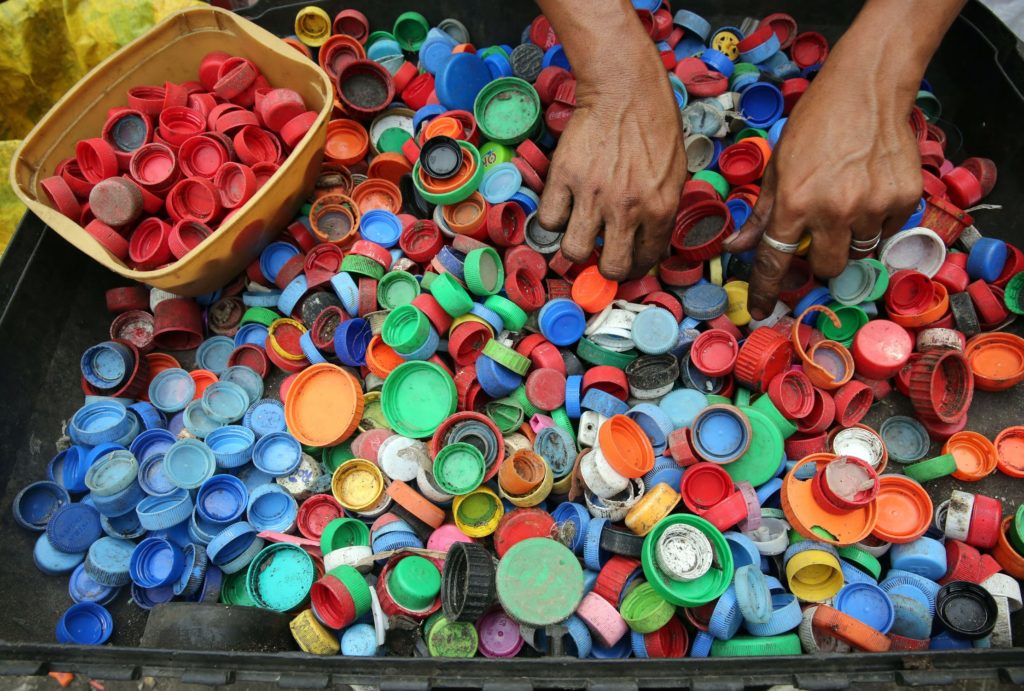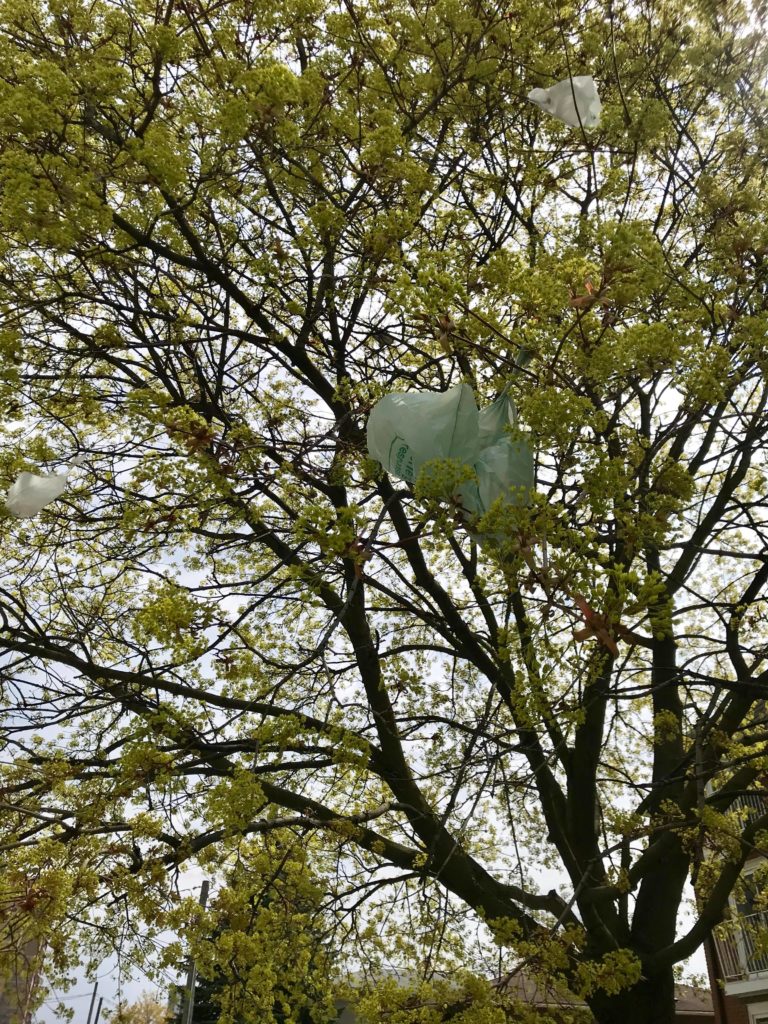
MATT: With the weather getting warmer and summer finally around the corner, it has been great to get outdoors and go for walks around town on weeknights and weekends. While its always nice to get out and enjoy a beautiful sunset and some fresh air, it is also fun to treat yourself every once in a while. On one such walk, we went to our local Dairy Queen for the first ice cream of the summer.
Of course my sweet tooth was absolutely craving more than just an ice cream cone – and given this long cold winter, it had been months since we had gone out and enjoyed a nice cool treat in the sun. Since this was the first ice cream of the season, I went all in and got a chocolate fudge cookie sundae 🙂 Not only was it delicious, but I couldn’t wait to go back and have another one. On finishing the delicious chocolate sundae, I realized that it had come in a plastic container, and there was nowhere to put that plastic container (and plastic spoon) other than in the garbage. Since started this blog, I have become more aware of things that are bad for the environment and one of the biggest culprits is the abundant use of plastic.

VASU: With each year almost 8 million tonnes of plastic being dumped into the ocean, it is no wonder that even the deepest parts of the planet are now plagued by plastic. Recently I saw how plastic wrappers and bags were found in the deepest part of the ocean – in the Mariana Trench, where even light doesn’t reach!! Imagine that, our destructive habits are now changing vulnerable ecosystems that have existed for thousands of years, even before our species came into existence.
According to a California-based non-profit called Plastic Oceans, microplastics are now found everywhere – including in food, drinking water and even our blood streams. Countries like Canada are big waste producers and those of you that follow the news must have heard about the recent scandal about how Western countries are exporting their plastics to developing ones like the Philippines.
This definitely makes us think that the blue box (plastic recycling we all feel so good about) is now ending up half way around the world – creating different problems (like a public health crisis due to plastic burning and land contamination). I hate to say it, but this is a classic example of a “not-in-my-backyard” attitude and it is definitely not helping reduce our plastic addiction.
Here is an excellent article in the CBC that talks about how our consumption-based lifestyles (where even small things like buying take-out) are making recycling products like plastics unsustainable. This article also talks about how the recycling industry is unable to keep up the demand that every disposable plastic (think about what’s in your fridge – from yogurt containers to individually wrapped cheese slices to frozen veggie bags) is now bringing. Yet governments or municipalities are not creating more recycling centres or even changing the supply chain (from plastic to zero waste) to meet this demand.
MATT: When you really think about it, there is plastic that comes with all foods that we buy or things we use. When we go to the grocery store, basically all the processed food is packaged or wrapped in some sort of plastic and so is the produce. Cucumbers, peppers, coconuts, even avocados are individually wrapped to “preserve freshness” and provide “appropriate portion sizes” to the consumer. Foods that are wrapped in plastic and then boxed in plastic are then purchased and placed into plastic grocery bags. We then take it home and throw that plastic away.
MATT & VASU: And with more and more landfills getting filled up and even other countries (like China and the Philippines) are finally saying no to waste – does the responsibility not lie with our elected representatives or even our large grocery-chains to deal with the plastic problem. So here you may ask, if it is their issue, why should we individuals care? Well, simply put, you are the ones that elect them or end up buying your weekly groceries from them. And these elected representatives or large grocery-stores need to respond to changing customer and social values if they are to stay relevant. Times are changing, especially with more and more young people getting access to information on harmful impacts of plastic.
We found this really interesting video from CBC marketplace which shows how different families and individuals are changing their habits when it comes to plastics at the grocery store.
Sadly, we have all seen the videos of how disposable single-use plastic straws can create havoc on marine life. The plastic dilemma is not an issue for just the government or companies. It is a question for all of us that use it in our daily lives, as to how much do we think we can do something about it?
MATT: Even if we put in the extra effort and sort and recycle that plastic most of it doesn’t end up being properly recycled. People are aware of all the needless plastic we consume and are willing to use less of it, however retailers find it cheaper and easier to use plastic to ship and sell foods so they keep doing it. When we go out shopping, we need to make a conscious effort to choose foods that have less or no plastics – that way retailers will notice our changing purchasing habits. It is a small step, but it definitely has a big impact on how many plastic bags we use!
MATT & VASU: So here are some tips from our life that can help you reduce your own plastic footprint:
- Bring reusable plastic bags when you go grocery shopping – now we are buying reusable cloth bags to bag produce (like carrots, peppers, beans, tomatoes, apples etc) at the grocery stores. You can check similar ones on Amazon or Well.ca.
- Go to your local farmer’s market to buy fresh and non-packaged food. Bring your reusable bags and don’t forget that supporting local is another step towards reducing your grocery’s carbon and travel footprint.
- We are looking into switching from plastic resealable bags to getting a compostable and natural alternative called bees wrap. However, this is a choice you can make by looking in the pros and cons of it. If not, try to rewash your plastic reusable bags and reuse them more than once.
- Know which plastic can be recycled and which cannot. This is very context and region dependent so make sure to check out what your municipality recommends. For us, here is what the Region of Waterloo recommends.
- One interesting tip is to reuse those milk bags and other plastic bags. Here is an article that talks about repurposing them in 11 different ways. If you are into arts and crafts, think of ways you can repurpose them into artwork or even mattresses. Here’s one resource to check out how to turn grocery bags into a rug.
- We recently switched from using plastic tupperware to glass tupperware for our lunches as well as in storing things. An excellent online store that is solely dedicated to not using plastic is Life Without Plastic! Check them out and see what cool home and wellness products you can buy, that will make you feel good about taking baby steps to cut your plastic lifestyle.
- And lastly, start talking about it! Even if it is just with your friends, partner, kids or colleagues. The first step is always awareness. And the second step is sending a letter or calling your local politician or grocery store to find out what they are doing about transitioning away from plastic.
